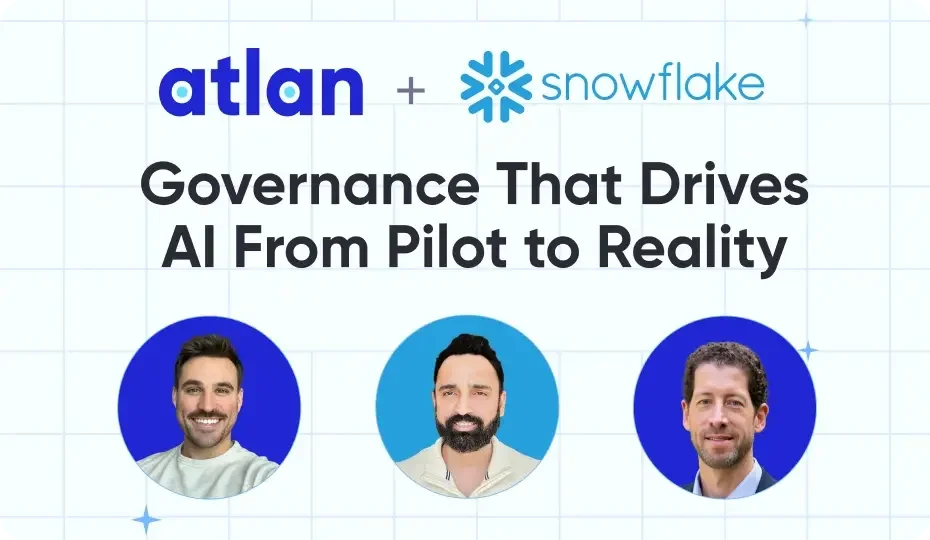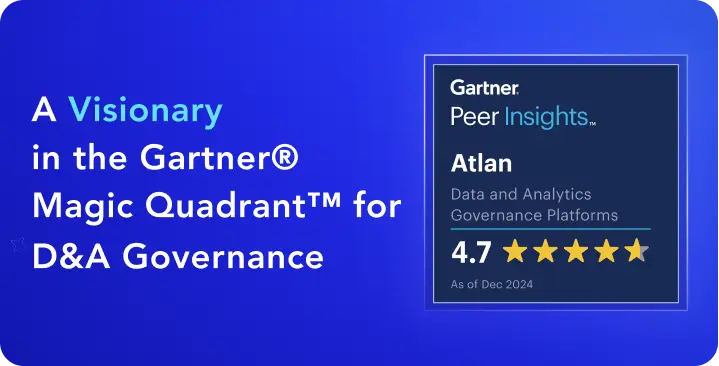Are you considering Alation as your choice of data catalog? Wondering about its pricing model? In this article, we’ll look at how to understand the total cost of ownership of your data catalog - and what you might spend with Alation.
Save Your Seat To See Atlan in Action - Live Demo Series
Alation pricing involves various factors that influence the total cost of ownership. Understanding these elements is crucial for organizations considering Alation as their data catalog solution. Key aspects include licensing costs, implementation fees, and ongoing support expenses.

Looking for a data catalog with an ROI you can present to your CDO? Atlan is designed for adoption and embedded with automation. It helps you save time, cut cloud costs, and make faster, better decisions that lead to revenue.
Request a personalized Atlan demo ✨ tailored to your needs
Table of contents #
- What is Alation?
- Understanding data catalog pricing
- Basics of Alation pricing
- Challenges with the Alation pricing model from a TCO perspective
- How has Alation’s pricing structure evolved recently?
- Is Alation worth the price?
- How organizations making the most out of their data using Atlan
- FAQs about Alation Pricing
- Related reads
What is Alation? #
Founded in 2012, Alation is one of the first data catalogs on the market. Their product suite consists of three main components:
- Alation Data Catalog: Enables cataloging of a company’s data, searching it using natural language queries, detecting data anomalies, and establishing basic data governance rules.
- Alation Connectors: Software components that enable integration of data from data warehouses, data lakes, and data lake houses.
- Alation Data Governance App: A separate UI for creating, deploying, and enforcing data management policies.
In recent years, Alation has rushed to add new features in an attempt to align with customers’ expectations for a modern data catalog.
Gartner’s Inaugural Magic Quadrant for D&A Governance is Here #
In a post-ChatGPT world where AI is reshaping businesses, data governance has become a cornerstone of success. The inaugural report provides a detailed evaluation of top platforms and the key trends shaping data and AI governance.
Read the Magic Quadrant for D&A Governance
Understanding data catalog pricing #
The total cost of a data catalog is more than just licensing. So, before we dive into Alation pricing, let’s take a step back.
A data catalog enables people in your company to find, trust, share, and track data across the entire organization. That requires interfacing with many other components of your architecture and modern data stack.
As such, when evaluating the true pricing of a data catalog, you need to take into account:
- Base licensing costs. How a data catalog charges for its base licensing costs will differ by vendor. Elements of licensing may include:
- Number of regular users
- Number of administrative users
- Licensing costs for data connectors, the components that interface with data storage solutions and other data providers, like Snowflake, Amazon Redshift, and traditional databases
- Separate licensing costs for other add-ons
- Hosting costs. Are you hosting your data catalog on-site? Or in the cloud? Or are you purchasing a Software as a Service (SaaS) implementation directly from the vendor? Many companies will opt to host in the cloud so they can easily integrate their data catalog with their other cloud infrastructure. If you choose this route, you’ll need to pay your cloud provider for compute costs. You may also incur data egress costs when you transfer from the provided virtual private networks to the Internet or other cloud regions.
- Implementation costs. Does the product support a DIY setup? Or is it difficult to integrate with your data stores, authentication systems, and other IT infrastructure? Even a product with reasonable licensing can become expensive if you must devote weeks or months of engineering hours before anyone can use it.
- Training costs. How easy or difficult is the tool to use? How much time does it take to onboard employees so they can make productive use of your data catalog? A product that’s hard to use adds to costs in terms of additional support hours and lost employee productivity.
- Ongoing support and maintenance costs. No piece of software is ever problem-free. Eventually, your IT staff will need to assist with issues - and you’ll likely need assistance from the vendor. It’s important to assess how much support will cost - and whether you’ll get the support that you need from your vendor.
Of these, base licensing costs are the easiest to calculate. Implementation, training, and support can be more tricky. It’s best to research what other customers have experienced in these areas and formulate some rough estimates before you commit.
Basics of Alation pricing #
It’s hard to get a sense of Alation pricing because the company doesn’t publish pricing information. That’s no surprise. As we saw, there are multiple factors to data catalog pricing, making it hard to set out a one-size-fits-all price.
The best we can do is glean a little bit about past pricing from other sources.
Breakdown: Alation implementation and licensing costs #
For example, GigaOm did a breakdown not too long ago comparing the prices of various cloud-based analytics stacks. They also looked at various data catalog offerings, comparing Snowflake with Alation pricing against Azure Purview, Amazon Glue Data Catalog, and Google Data Catalog.
In GigaOm’s estimates, the Snowflake with Alation option was the most expensive. GigaOm estimated that, for a medium enterprise solution, customers would spend USD $4,128,722 a year for their stack.
The Alation portion of that cost came out to $413,660. That includes $198,000 in base licensing costs for 25 contributors. The rest of the cost came from cloud hosting.
Alation proved more costly than competitors #
GigaOm points out that, in its breakdowns, the cost for Alation outstripped the data catalog costs of similar solutions. In the AWS, Microsoft, and Google stacks, the data catalog came out to less than 1% of the total stack cost. But it was 10% of the total cost of the Snowflake stack.
However, this comparison is sort of like apples and oranges. The cloud vendor-specific data catalog offerings, such as Google Data Catalog, don’t support the features - like data lineage, embedded collaboration, and granular governance - that customers have come to expect from modern data catalogs.

Looking for a data catalog with an ROI you can present to your CDO? Atlan is designed for adoption and embedded with automation. It helps you save time, cut cloud costs, and make faster, better decisions that lead to revenue.
Request a personalized Atlan demo ✨ tailored to your needs
Challenges with the Alation pricing model from a TCO perspective #
As we wrote earlier, it’s best to consider input from current and previous customers when evaluating a vendor’s data catalog total cost of ownership. A look at customer feedback on Alation’s pricing model and installation provides some pause for concern.
- Lack of DIY setup. Alation requires the help of system integrators who specialize in the product. No true DIY process available. Even then, according to several customers, it can be a struggle to get Alation up and running. Others report issues getting Alation’s data connectors to work properly.
- Unexpected add-on charges. Customers have reported Alation charging them for various required add-ons. This only adds to the total licensing cost.
- Time to experience value. Long time to value, often taking a year or more, after a cumbersome multi-month deployment cycle. Lack of adoption can slow down the pace.
- Limited flexibility. Alation is a legacy platform. As your tech stack grows, Alation may not be able to evolve with it. This limits long-term ROI.
How has Alation’s pricing structure evolved recently? #
There are signs Alation is lowering its pricing to remain competitive. The data catalog market is hot. Estimates say it’s likely to be a $448 billion market by 2027. That means there’s a lot of innovation and progress happening at a rapid pace - especially in areas such as data centralization, data governance, and AI. Given this, it’s likely that, as Alation’s feature set falls behind, it’s cutting prices to keep its offering attractive.
For example, we know the company is testing out a new, asset-based pricing model. This promises to lower costs for customers upon initial entry. However, it could result in higher costs as customers increase the scale of data estate assets managed by Alation.
Is Alation worth the price? #
Modern data catalogs do more than just cataloging. Support for features like visual data lineage, collaboration, and active, programmable data governance are critical for keeping up with the data demands of today’s market.
There are signs that Alation is feeling the pressure from the competition. Several users noted that the product’s data lineage features don’t feel “ready for prime time.” Others pointed out that the system still doesn’t handle lineage well across multiple data sources. Customers also reported usability concerns around common features like search filtering, reporting, and Power BI support.
We created Atlan to deliver a modern data catalog that gives customers the tools they need. Atlan supports a DIY setup and an easy-to-use UI that reduces ramp-up time and total cost of ownership. We’ll work with you to put together a pricing package that delivers a solid return on your investment.

Looking for a data catalog with an ROI you can present to your CDO? Atlan is designed for adoption and embedded with automation. It helps you save time, cut cloud costs, and make faster, better decisions that lead to revenue.
Request a personalized Atlan demo ✨ tailored to your needs
How organizations making the most out of their data using Atlan #
The recently published Forrester Wave report compared all the major enterprise data catalogs and positioned Atlan as the market leader ahead of all others. The comparison was based on 24 different aspects of cataloging, broadly across the following three criteria:
- Automatic cataloging of the entire technology, data, and AI ecosystem
- Enabling the data ecosystem AI and automation first
- Prioritizing data democratization and self-service
These criteria made Atlan the ideal choice for a major audio content platform, where the data ecosystem was centered around Snowflake. The platform sought a “one-stop shop for governance and discovery,” and Atlan played a crucial role in ensuring their data was “understandable, reliable, high-quality, and discoverable.”
For another organization, Aliaxis, which also uses Snowflake as their core data platform, Atlan served as “a bridge” between various tools and technologies across the data ecosystem. With its organization-wide business glossary, Atlan became the go-to platform for finding, accessing, and using data. It also significantly reduced the time spent by data engineers and analysts on pipeline debugging and troubleshooting.
A key goal of Atlan is to help organizations maximize the use of their data for AI use cases. As generative AI capabilities have advanced in recent years, organizations can now do more with both structured and unstructured data—provided it is discoverable and trustworthy, or in other words, AI-ready.
Tide’s Story of GDPR Compliance: Embedding Privacy into Automated Processes #
- Tide, a UK-based digital bank with nearly 500,000 small business customers, sought to improve their compliance with GDPR’s Right to Erasure, commonly known as the “Right to be forgotten”.
- After adopting Atlan as their metadata platform, Tide’s data and legal teams collaborated to define personally identifiable information in order to propagate those definitions and tags across their data estate.
- Tide used Atlan Playbooks (rule-based bulk automations) to automatically identify, tag, and secure personal data, turning a 50-day manual process into mere hours of work.
Book your personalized demo today to find out how Atlan can help your organization in establishing and scaling data governance programs.
FAQs about Alation Pricing #
1. What is Alation pricing and what factors influence it? #
Alation pricing varies based on several factors, including the number of users, licensing options, and additional features. Organizations should consider base licensing costs, implementation expenses, and ongoing support when evaluating total costs.
2. How does Alation’s pricing compare to other data catalog solutions? #
Alation’s pricing is generally higher than some competitors, reflecting its comprehensive features and capabilities. Organizations should compare Alation’s offerings with alternatives like Atlan to determine the best fit for their needs.
3. Are there any hidden costs associated with Alation pricing? #
Yes, users have reported unexpected add-on charges and implementation costs that can increase the total cost of ownership. It’s essential to review all potential expenses before committing to Alation.














